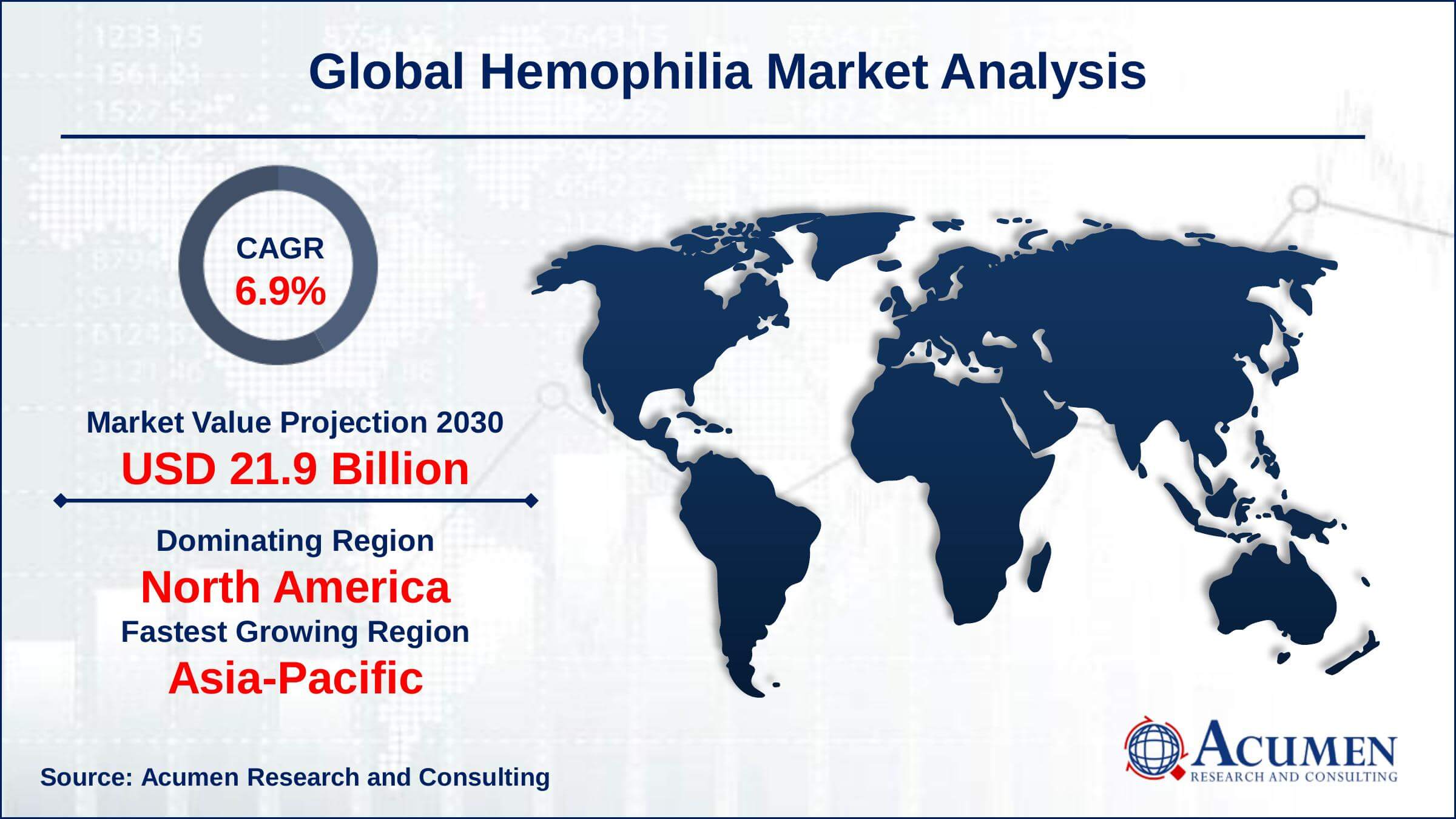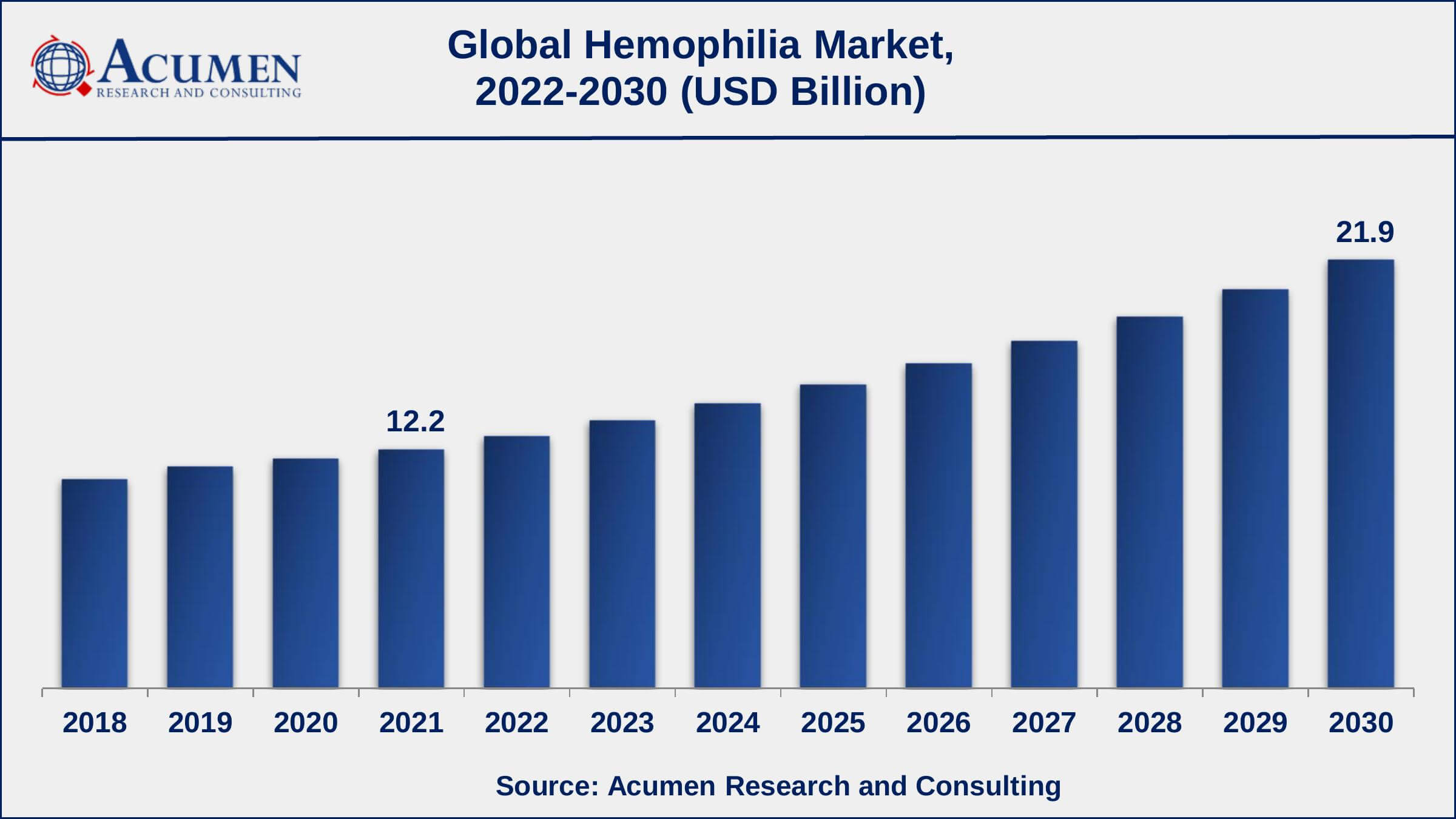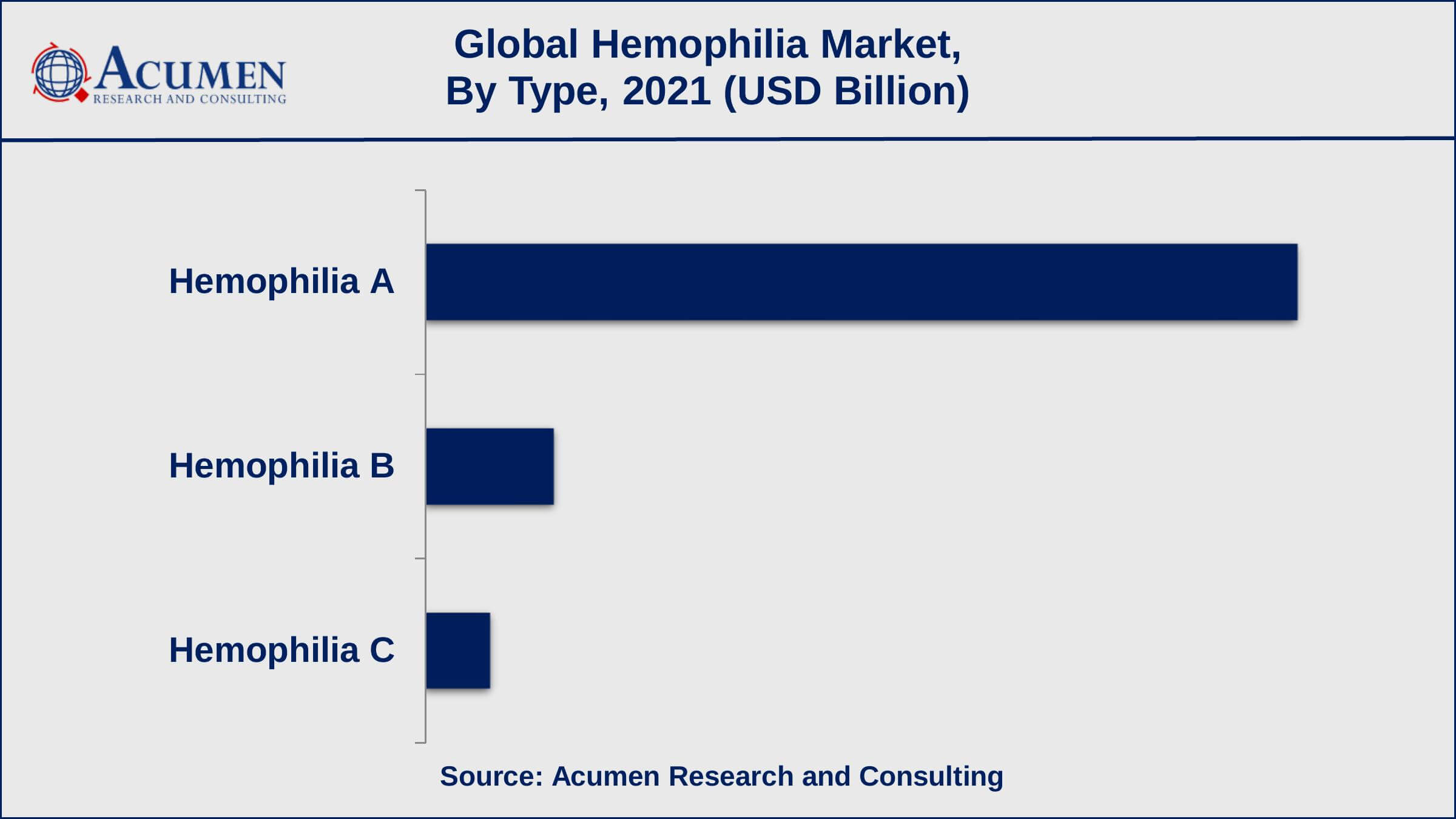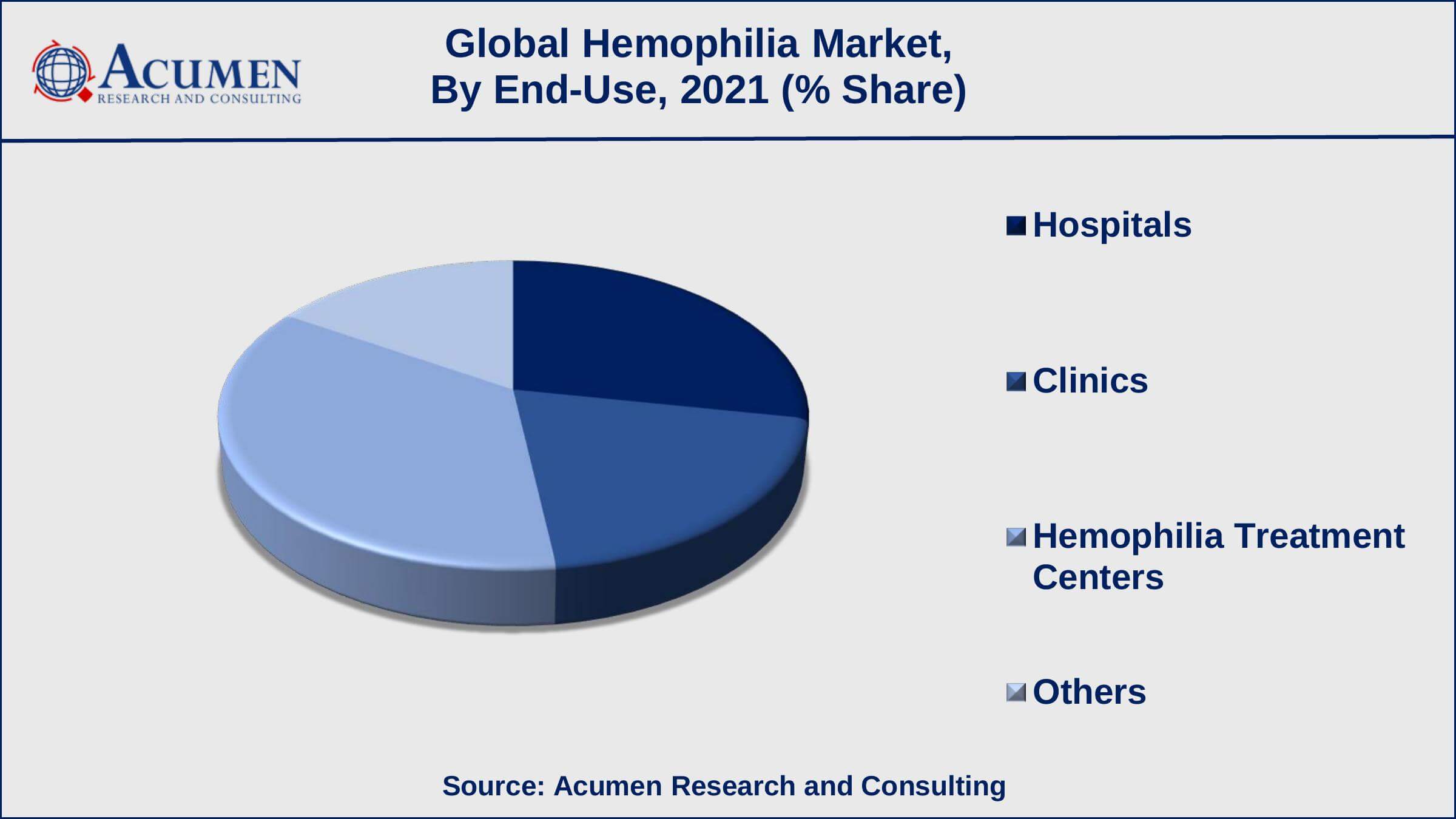The Global Hemophilia Market Size accounted for USD 12.2 Billion in 2021 and is projected to occupy a market size of USD 21.9 Billion by 2030 growing at a CAGR of 6.9% from 2022 to 2030.
According to the Centers for Disease Control and Prevention (CDC), hemophilia is a disorder in which a person's blood does not clot normally, which can result in spontaneous or excessive bleeding. According to a recent survey, 1,125,000 patients have hemophilia in the world. Hemophilia is almost always an inherited condition. Introduction of new drug development is a leading trend in hemophilia industry that is gaining significance prominence across the world.
Hemophilia Market Report Statistics
- Global hemophilia market revenue is projected to reach USD 21.9 Billion by 2030 with a CAGR of 6.9% from 2022 to 2030
- According to the Centers for Disease Control and Prevention (CDC), hemophilia occurs in roughly 1 in 5,617 live male births
- North America hemophilia market share generated over 44% shares in 2021
- As per the CDC statistics, 12 per 100,000 males have hemophilia A in the United States
- In addition to that, 400 boys in the U.S are born with hemophilia A condition
- Asia-Pacific hemophilia market growth will record noteworthy CAGR of over 7% from 2022 to 2030
- Based on type, hemophilia A recorded 82% of the overall market share in 2021
- Among end-use, hemophilia treatment centers accounted for USD 4.4 billion in 2021
- Increasing adoption of prophylaxis treatment is a popular hemophilia market trend that fuels the industry demand
Global Hemophilia Market Dynamics
Market Drivers
- Increasing prevalence of hemophilia in the world
- Growing incidences of hemophilia in new-borns
- Growth in hemophilia inhibitors
- Surging trend of prophylaxis treatment
Market Restraints
- High cost linked with hemophilia treatment
- Low adoption rates of technologically advanced products in developing countries
Market Opportunities
- Increasing R&D and new product launch
- Rising favorable government initiatives
Hemophilia Market Report Coverage
| Market | Hemophilia Market |
| Hemophilia Market Size 2021 | USD 12.2 Billion |
| Hemophilia Market Forecast 2030 | USD 21.9 Billion |
| Hemophilia Market CAGR During 2022 - 2030 | 6.9% |
| Hemophilia Market Analysis Period | 2018 - 2030 |
| Hemophilia Market Base Year | 2021 |
| Hemophilia Market Forecast Data | 2022 - 2030 |
| Segments Covered | By Type, By Treatment, Therapy, End-Use, And By Geography |
| Regional Scope | North America, Europe, Asia Pacific, Latin America, and Middle East & Africa |
| Key Companies Profiled | Baxalta, CSL Behring, Pfizer, Inc., Bayer Healthcare, BioMarin Pharmaceutical, Inc., Biogen, Chugai Pharmaceutical Co., Novo Nordisk, Shire Plc., and others. |
| Report Coverage |
Market Trends, Drivers, Restraints, Competitive Analysis, Player Profiling, Regulation Analysis |
Hemophilia Market Growth Factors
The increasing initiatives at the global level to create awareness about hemophilia drugs from the government, as well as non-government organizations, is one of the prime factors boosting the market growth. Also, the increase in delivering a prophylactic treatment is likely to fuel the demand for hemophilia. Treatment entails replacing the reduced clotting factor on a regular basis. Newer therapies that do not include clotting factors are also being used.
The lack of awareness about the hemophilia is one of the major restraining factors limiting the growth of the market but the government and non-government agencies are increasing conducting programs to increase awareness about hemophilia. Hence, such activities are expected to promote the awareness and applications of hemophilia drugs and boost market growth.
Hemophilia Market Insights
According to the National Hemophilia Organization, the exact number of worldwide incidence of hemophilia is not well known, but it is estimated at more than 1.1 million people. The organization also states that approximately 75% of people with hemophilia around the world still receive inadequate treatment or have no access to treatment. The manufacturers of treatment drugs for this disorder are facing a significant challenge while coming up with suitable treatment for hemophilia as there is no exact drug is available. The regulatory bodies are facing increasing pressure to create a therapy for hemophilia disorder and due to such factors; the research and development projects are increasing rapidly.
Hemophilia Market Segmentation
The global hemophilia market is segmented based on type, treatment, therapy, end-use, and geography.
Hemophilia Market By Type
- Hemophilia A
- Hemophilia B
- Hemophilia C
According to our hemophilia industry analysis, the hemophilia A sub-segment held more than 82% of the market share in 2021 and is predicted to continue this trend in the coming years. Hemophilia A, the most common type of hemophilia, is caused by a lack of clotting factor 8. Males are far more likely to have Hemophilia A. It is uncommon in females. People who have hemophilia A tend to bleed for longer periods of time than others. According to the Cleveland Clinic, 60 to 70 percent of people with hemophilia A have severe hemophilia and 15 percent have moderate hemophilia. The remainders have a mild form of the disease.
Hemophilia Market By Treatment
- On-Demand
- Prophylaxis
According to our hemophilia market forecast, on-demand treatment is likely to hold maximum share from 2022 to 2030. In terms of growth, prophylaxis treatment is expected to gain significant impetus during the forthcoming period. Prophylaxis is a frequent infusion of clotting factor concentrates used in patients with severe hemophilia and is a commonly accepted treatment among patients, contributing to its growth rate.
Hemophilia Market By Therapy
- Replacement Therapy
- Gene Therapy
The importance of hemophilia drugs in delivering a gene therapy and replacement therapy is foreseen to be a key driver for market growth. Because hemophilia is a genetic disorder, it must be treated with adequate and effective medical treatment dosages. Because of their high effectiveness, hemophilia treatments such as replacement therapy have seen a significant increase in demand over the years, and this trend is likely to sustain in the coming few years. Replacement therapy involves slowly injecting clotting factor VII (for haemophilia A) or clotting factor IX (for haemophilia B) concentrates into a vein, where they replace the missing proteins.
Hemophilia Market By End-Use
- Hospitals
- Clinics
- Hemophilia Treatment Centers
- Others
Based on end-use segment, hemophilia treatment centers grabbed a noteworthy market share owing to the precise treatment options available. The hospitals sub-segment accounted for second largest market share, owing to the availability of board-certified skilled haematologists, the importance of delivering quality care plans, and their improved efficiency, among other factors.
Hemophilia Market Regional Outlook
North America
- U.S.
- Canada
Europe
- U.K.
- Germany
- France
- Spain
- Rest of Europe
Asia-Pacific
- India
- Japan
- China
- Australia
- South Korea
- Rest of Asia-Pacific
Latin America
- Brazil
- Mexico
- Rest of Latin America
The Middle East & Africa
- South Africa
- GCC Countries
- Rest of the Middle East & Africa (ME&A)
Hemophilia Market Regional Analysis
Considering the demand for Hemophilia, the North America region is dominating the hemophilia market in 2021. The North America region is predicted to continue its dominance over the end of the forecast period by holding the share of more 44%. The increasing inclination toward treatment of prophylaxis is expected to be the key factor driving the growth in this region.
According to a global survey conducted by WHF (World Federation of Hemophilia) in 2015, approximately 63.0% of the patients in the U.S. have opted for prophylaxis treatment. The adoption of such treatment options is resulting in the acceleration of the market.
Among the other regions, the Asia-Pacific region is anticipated to witness the substantial growth over the forecast period by registering the highest CAGR growth. Increasing awareness about hemophilia among the emerging countries including India, Indonesia, Malaysia, Japan, and others is expected to boost the market growth. In addition, the increasing disposable income backed by the advancements in the medicinal treatments such as the use of therapies for the treatment of hemophilia disorder is fuelling the demand for hemophilia.
Hemophilia Market Players
The hemophilia market is highly dominated by leading players as it is a rare disorder and no accurate treatment is present for this disorder. Some of the key players in this industry include Baxalta, CSL Behring, Pfizer, Inc., Bayer Healthcare, BioMarin Pharmaceutical, Inc., Biogen, Chugai Pharmaceutical Co., Novo Nordisk, Shire Plc., and others.
These players are leveraging their current position in this market and also implementing some strategies to fuel revenue pocketing process by selling drugs. Some of the prominent strategies include geographical expansion to new regions and increasing investments in R&D for developing improved medicine alternatives.
Frequently Asked Questions
The market size of hemophilia market in 2021 was accounted to be USD 12.2 Billion.
The projected CAGR of hemophilia market during the analysis period of 2022 to 2030 is 6.9%.
The prominent players of the global hemophilia market include Baxalta, CSL Behring, Pfizer, Inc., Bayer Healthcare, BioMarin Pharmaceutical, Inc., Biogen, Chugai Pharmaceutical Co., Novo Nordisk, and Shire Plc.
North America held the dominating hemophilia during the analysis period of 2022 to 2030.
Asia-Pacific region exhibited fastest growing CAGR for hemophilia during the analysis period of 2022 to 2030.
Increasing prevalence of hemophilia in the world, growing incidences of hemophilia in new-borns, growth in hemophilia inhibitors, and surging trend of prophylaxis treatment drives the growth of global hemophilia market.
Based on type, hemophilia A segment is expected to hold the maximum share of the hemophilia market.






